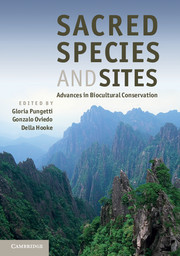Book contents
- Frontmatter
- Contents
- List of Contributors
- Foreword
- Preface
- Acknowledgements
- Introduction
- Part I Concepts and Knowledge
- Part II Sacred Landscapes
- Part III Sacred Sites and People
- 9 The landscape in the cosmoscape, and sacred sites and species among the Tanimuka and Yukuna Amerindian tribes (north-west Amazon)
- 10 Sacred natural sites in zones of armed conflicts: the Sierra Nevada de Santa Marta in Colombia
- 11 Struggles to protect Puketapu, a sacred hill in Aotearoa
- 12 The Roman goddess Care: a therapy for the planet
- Part IV Sacred Species
- Part V Sacred Animals
- Part VI Sacred Groves and Plants
- Part VII Implementation and Conclusions
- Index
- Plate Section
- References
12 - The Roman goddess Care: a therapy for the planet
from Part III - Sacred Sites and People
Published online by Cambridge University Press: 05 August 2012
- Frontmatter
- Contents
- List of Contributors
- Foreword
- Preface
- Acknowledgements
- Introduction
- Part I Concepts and Knowledge
- Part II Sacred Landscapes
- Part III Sacred Sites and People
- 9 The landscape in the cosmoscape, and sacred sites and species among the Tanimuka and Yukuna Amerindian tribes (north-west Amazon)
- 10 Sacred natural sites in zones of armed conflicts: the Sierra Nevada de Santa Marta in Colombia
- 11 Struggles to protect Puketapu, a sacred hill in Aotearoa
- 12 The Roman goddess Care: a therapy for the planet
- Part IV Sacred Species
- Part V Sacred Animals
- Part VI Sacred Groves and Plants
- Part VII Implementation and Conclusions
- Index
- Plate Section
- References
Summary
‘The XXI Century will either be spiritual or it won't be at all’.
(André Malraux)‘Blessed be the water, blessed be the earth, blessed be the air, blessed be the forest, blessed be the cloud and the rain: protect us and make us fall in love with you’.
(Berito Kuwaru'wa, spokesperson of the UWA people of Colombia)Introduction: principles, concepts and values
‘Dea Cura’, the Goddess Care, could be considered a minor deity within the superabundant Roman Pantheon. Yet she had a most peculiar and literally vital role. Her task was to give shape and mould to human beings so as to ensure the continuity of life within them. Life without shape, without an intentionally cast mould, constantly redesigned, maintained and purposely taken care of, simply could not exist. Goddess Care – and the set of concepts and principles which guided her mission in ancient Latin times – is of relevance to humankind of the third millennium as well. She might hand us the right ingredients of the most needed recipe for our era, an adequate therapy for Mother Earth, gripped in the most severe and global ecological crisis humans have ever caused.
Her very name – Nomen omen in Latin (name-giving is not neutral: it evokes and contains the destiny of each living being) – was thus extremely significant. ‘Cura’ implies a mix of concepts and feelings which involve both the mental and the physical level, the emotional as well as the rational response.
- Type
- Chapter
- Information
- Sacred Species and SitesAdvances in Biocultural Conservation, pp. 178 - 192Publisher: Cambridge University PressPrint publication year: 2012
References
- 1
- Cited by



